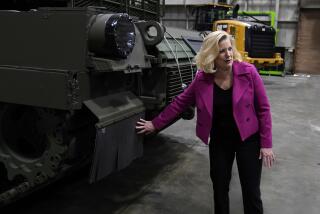From fortunes of war to the poverty of peace.
WARREN, Mich. — Mikhail S. Gorbachev may be lionized around the world as the harbinger of peace and freedom, but don’t tell that to Phil Milavec.
“If they want to take the Russians’ word for it . . . agh!” spits out Milavec. “I wouldn’t.”
Don’t tell Skip Turner that the U.S. Army’s M1A1 Main Battle Tank, a 67-ton, $2.5-million monster designed to plow up Russian soldiers as it churns through the rolling terrain of central Germany, is now of another age, a museum-piece from a more threatening era that ended, oh, maybe six months ago.
“The Russians,” insists Turner, “are still building 1,500 tanks a year.
“And now, we’re not going to build any.”
Milavec and Turner, along with 1,400 others here at the General Dynamics Corp.’s Warren tank factory, have cause to talk so bitterly about the massive changes taking place in the world today.
They are caught in the middle of a most unusual plant closing, one brought on by wonderful news. So they see themselves as the first American victims of a world turned upside down, a world where the thunder of war seems more distant than ever.
For them, the Cold War is over. And they lost.
“We feel like we are the victims of peace,” says Turner, a union official at the plant. “Maybe not of peace, really, but of hasty decision-making. After you’ve been fighting for 20 or 30 years, you shouldn’t let your guard down right away.”
The Pentagon, which only a few months ago was negotiating with General Dynamics over a contract to build 3,000 new tanks for deployment in Europe, suddenly in January pulled the plug on all tank production in the United States.
The Defense Department announced, in its 1991 budget, that with peace at hand, America’s only two tank plants--Warren and a sister factory in Lima, Ohio--were to be mothballed, and the Army would have to make do with its 8,000 M1 tanks already in stock.
Congressional leaders from Michigan and Ohio are fighting the Pentagon’s decision, but as it stands now, Warren will close by September, 1991, and Lima by March, 1993, after filling out current orders from the Army and foreign customers.
The M1 tank, a mainstay of America’s conventional armament, will thus become one of the first--and certainly one of the most important--weapons systems to be sacrificed by the Pentagon since Gorbachev’s reforms and the ongoing upheaval in Eastern Europe started talk of a “peace dividend” in Washington.
Warren’s employees are going down with their tank, the first of what could become a tidal wave of defense workers in the coming years who will be forced to find a way to wedge themselves into the civilian economy.
One of them, William Vivian, a country boy who has never worked anywhere else, wonders where he can go, how he will feed his five kids.
“I’ve never been out of work before, I don’t even know how to look for a job anymore,” says Vivian, with a trace of fear in his voice. “I may have to get two jobs just to make as much as I make here.”
Vivian and others here simply don’t understand why they are being discarded so quickly, so easily, after what they see as decades of work helping to preserve the peace. Worse, the news of the closing hit Warren just two days after the Army presented the plant with its highest award for industrial quality.
“You get these awards and then they double-talk you,” quality inspector Milavec says angrily.
Yet Warren’s closing offers the first evidence that the American military-industrial base that grew up during and after World War II may not survive the collapse of the Soviet Empire. Warren has been the nation’s prime tank plant since 1940, when Franklin D. Roosevelt asked Chrysler to get into the defense business.
During World War II, Warren was at the heart of America’s arsenal of democracy; the plant churned out 20,000 of the 80,000 tanks produced throughout the United States between 1941 and 1945.
Ever since, the massive factory has been a key economic anchor in this Detroit suburb, the production arm of the U.S. Army’s Tank and Automotive Command, which is headquartered down the street.
And, in a region that knows only too well the volatile swings of the auto industry, the plant’s stability was its greatest attraction; jobs in the tank plant once seemed to offer the kind of security that wasn’t available at Cadillac or Ford.
No more.
“I feel like we’re getting sold out,” says tank assembler Bob Robertson. “As far as the government is concerned, I think they are crazy, disarming like this, because with the way the world is going, things could turn around just as easily.”
Others wonder about the Pentagon’s priorities. Why, they ask, has it given up so completely on tanks, while pushing for more missiles and bombers to strike Moscow?
Says Turner with a sigh: “For the price of one Stealth bomber, we could run this plant for a year.”
More to Read
Sign up for Essential California
The most important California stories and recommendations in your inbox every morning.
You may occasionally receive promotional content from the Los Angeles Times.










